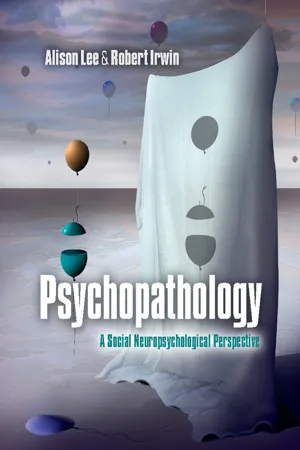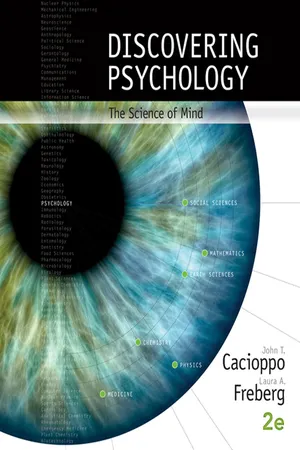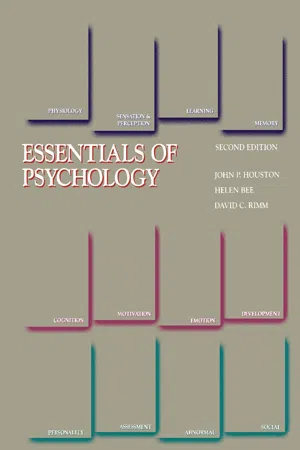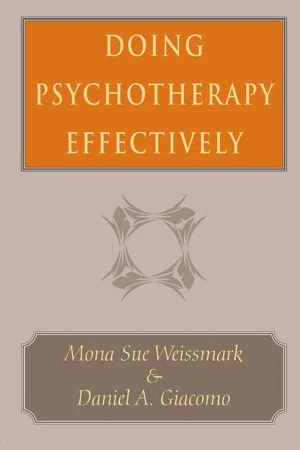Psychology
Types of Therapy
Types of therapy in psychology refer to the various approaches and techniques used to address mental health issues and improve well-being. Common types include cognitive-behavioral therapy (CBT), psychodynamic therapy, humanistic therapy, and family therapy. Each type of therapy has its own theoretical foundation and methods for helping individuals cope with and overcome psychological challenges.
Written by Perlego with AI-assistance
Related key terms
1 of 5
12 Key excerpts on "Types of Therapy"
- eBook - PDF
Essentials of Psychology
Concepts and Applications
- Jeffrey Nevid(Author)
- 2021(Publication Date)
- Cengage Learning EMEA(Publisher)
3. Identify the major types of psychotherapy and the develop- ers of these therapies and describe techniques used in these different types of psychotherapy. Psychodynamic therapy is an insight-oriented approach to therapy based on Freud’s model, which he called (d) ________. The psychodynamic therapist helps clients uncover and work through the (e) ________ conflicts dating from childhood that are believed to be at the root of their problems. Carl Rogers was the major developer of (f) ________ therapy, which focuses primarily on the client’s subjec- tive, (g) ________ experience in the here and now. Behavior therapy involves the systematic application of (h) ________ principles to help people unlearn maladaptive behaviors and acquire more adaptive behaviors. The techniques of behavior therapy include (i) ________ desensitization, gradual exposure, modeling, aversive conditioning, and methods based on operant conditioning. Cognitive behavioral therapy is a broader form of behavior therapy that incorporates both behavioral and (j) ________ techniques in treatment. Cognitive thera- pies, such as rational emotive behavior therapy (REBT) developed by Albert (k) ________ and cognitive therapy developed by Aaron (l) ________, focus on modifying the individual’s maladaptive thoughts and beliefs that are believed to underlie emotional problems, such as anxiety and depression, and self-defeating or maladaptive forms of behavior. In (m) ________ therapy, therapists adopt principles or techniques from different schools of therapy. 4. Identify and describe forms of therapy that involve more than the individual client. Copyright 2022 Cengage Learning. All Rights Reserved. May not be copied, scanned, or duplicated, in whole or in part. Due to electronic rights, some third party content may be suppressed from the eBook and/or eChapter(s). Editorial review has deemed that any suppressed content does not materially affect the overall learning experience. - eBook - PDF
- Aparna Raghvan(Author)
- 2019(Publication Date)
- Society Publishing(Publisher)
Psychotherapy 29 2.2. TYPES OF PSYCHOTHERAPY 2.2.1. Humanistic Therapy In this type of therapy, you centralize on yourself as an individual and not as a collective group. You look at your personality and nature in a positive way to try and figure out the problem. Humanistic therapy is very useful in dealing with a wide range of challenges that people have to deal with including body image issues, people who are struggling with either eating too much or not eating at all, individuals who are in a depressive state, not having confidence in themselves and their abilities, panic attacks, drug abuse, and anxiety disorders. The emphasis of humanistic therapy is to concentrate on special phenomena as the gift of free will, human potential, and creativity. The psychiatrist views the whole of the person and not just one part and tries to understand what could be the cause of your problem. These therapies help in the understanding of the here and now (Figures 2.1 and 2.2). Figure 2.1: A man sitting quietly by the lake thinking and meditating about his life. Source: Pinterest. Psychotherapy & Spirituality 30 Figure 2.2: A lady doing yoga as part of the holistic treatment. Source: Pinterest. 2.2.2. Existential Therapy There is existential-humanistic therapy in which the person has to look at life the way it is and make decisions according to the situation at hand. Existential therapy is the kind that centers on the whole of the being; it congratulates the goals achieved and is very positive towards future achievements. Let’s look at them in a broader view. It stands out from other therapies because it looks at the whole of a human rather than just get a few aspects and base findings on that. It is more philosophical than technical. The fact that it doesn’t dwell on the past experiences helps a person to deal with whatever is disturbing them in the present state. - eBook - PDF
Psychopathology
A Social Neuropsychological Perspective
- Alison Lee, Robert Irwin(Authors)
- 2018(Publication Date)
- Cambridge University Press(Publisher)
10 Psychological Therapies Introduction With over 400 different types of psychological therapy, it is unsurprising that no definition exists that adequately captures this diverse field of practice. Although modern psychological therapies have relatively short histories, the elements from which most are constituted are similar and date back many centuries (Jackson, 1999). For the purposes of this chapter, we use the term psychological therapy to refer to psychotherapy, counselling or any form of ‘talking treatment’ that aims to promote subjective well-being and mental health. This chapter aims to help you to think more critically about the claims made about psychological therapies. Firstly, we consider whether the practice of psychological therapy should be guided by diagnosis or formulation. This debate is, in part, about the extent to which the practice of psychological therapy can or should be decoupled from the medical model (Sanders, 2007; Deacon, 2013). In the next section, the focus shifts to how we can establish whether a psychological therapy works. Here we introduce and critique the concept of empirically supported therapies. Opinion within the field of psycho- logical therapy is generally divided as to which elements of therapy help to bring about change; some claim that it is therapeutic techniques and the theories that underpin them (the differential effectiveness position), while others argue that it is the quality of the therapeutic relationship and nonspecific factors (the common factors position). In the final part of the chapter, we consider some of the potential detrimental effects psychological therapy may have at an individual and societal level. 10.1 Diagnosis or Formulation? Whether practice should be guided by diagnosis or formulation is a moot point in the field of psychological therapy. In the therapeutic process, it is usually a diagno- sis or formulation that links assessment to therapeutic intervention or ‘treatment’. - eBook - PDF
Psychology and the Challenges of Life
Adjustment and Growth
- Spencer A. Rathus, Jeffrey S. Nevid(Authors)
- 2019(Publication Date)
- Wiley(Publisher)
• Thoughts, feelings, and behavior. Psychotherapy influences clients’ thoughts, feel- ings, and behavior. It can be aimed at any or all of these aspects of human psychology. • Psychological disorders, adjustment problems, and personal growth. Psychother- apy is often used with people who have psychological disorders. Other people seek help in adjusting to other types of problems such as shyness, weight problems, or loss of a spouse. Still other clients want to use psychotherapy in order to learn more about them- selves and to reach their full potential as individuals, parents, or creative artists. Let us consider the major psychotherapies therapies in use today. Psychodynamic Therapies: Digging Deep Within Psychodynamic therapies are based on the thinking of Sigmund Freud, the founder of psycho- dynamic theory. Freud believed that people don’t know themselves as well as they think they do, that all of us are driven by forces outside of our awareness. Freud assumed that the forces involve conflicts between three psychic structures or mental states: the id, ego, and superego (see Chapter 3). The origins of these conflicts trace back to childhood and revolve around difficul- ties reconciling primitive sexual and aggressive urges with the demands of social acceptability. Psychological problems arise when these long-hidden (repressed) sexual or aggressive impulses threaten to break the dam of the ego’s defenses and emerge into consciousness or when the superego floods us with excessive guilt. Freud’s method of therapy, called psychoanalysis, was the first psychodynamic therapy. It seeks to help people develop insight (self-awareness) psychotherapy The systematic interaction between a therapist and a client that applies psychological principles to affect the client’s thoughts, feelings, or behavior in order to help the client overcome psychological disorders, adjust to problems in living, or achieve personal growth as an individual. - eBook - PDF
- Spencer Rathus, , , (Authors)
- 2021(Publication Date)
- Cengage Learning EMEA(Publisher)
342 CHAPTER 13: Methods of Therapy 13 Methods of Therapy LEARNING OUTCOMES After studying this chapter, you will be able to . . . 13-1 Define psychotherapy and describe the history of treatment of psychological disorders. 13-2 Describe traditional psychoanalysis and short-term psychodynamic therapies. 13-3 Define humanistic therapy and contrast its two main approaches. 13-4 Define behavior therapy and identify various behavioral approaches to therapy. 13-5 Define cognitive therapy and describe the approaches of Aaron Beck and Albert Ellis. 13-6 Identify various types of group therapy and discuss their advantages and disadvantages. 13-7 Explain whether psychotherapy works and who benefits from it. 13-8 Describe methods of biological therapy and their benefits and side effects. asiseeit/E 1 /Getty Images Copyright 2022 Cengage Learning. All Rights Reserved. May not be copied, scanned, or duplicated, in whole or in part. Due to electronic rights, some third party content may be suppressed from the eBook and/or eChapter(s). Editorial review has deemed that any suppressed content does not materially affect the overall learning experience. Cengage Learning reserves the right to remove additional content at any time if subsequent rights restrictions require it. 343 CHAPTER 13: Methods of Therapy J oanne Cartwright (dubbed “Miss Muffet” by her therapist) had a spider phobia. “I washed my truck every night before I went to work in case there were webs,” she said (Robbins, 2000). “I put all my clothes in plastic bags and taped duct tape around my doors so spiders couldn’t get in. I thought I was going to have a mental breakdown. I wasn’t living.” She checked every crack in the sidewalk for spiders—if she could push herself to go outside at all. Finally, her crippling phobia made it all but impossible for her to leave the house. - eBook - PDF
- Douglas Bernstein, , , (Authors)
- 2015(Publication Date)
- Cengage Learning EMEA(Publisher)
538 Basic Features of Treatment . . . . . . . . . . . . . . . . . . . . . . . . . . . . . . . . . . . . 539 Psychodynamic Psychotherapy . . . . . . . . . . . . . . . . . . . . . . . . . . . . . . . . 541 Humanistic Psychotherapy . . . . . . . . . . . . . . . . . . . . . . . . . . . . . . . . . . . . . . . 543 Behavior Therapy and Cognitive Behavior Therapy . . . . . . . . . . . . . . . . . . . . . . . . . . . . . . . . . . . . . . . . . . . . . . . . . . . . . . 545 Group, Family, and Couples Therapy . . . . . . . . . . . . . . . . . . . . . . . . 552 Evaluating Psychotherapy . . . . . . . . . . . . . . . . . . . . . . . . . . . . . . . . . . . . . . . . 554 Thinking Critically: Are All Forms of Therapy Equally Effective? . . . . . . . . . . . . . . . . . . . . . . . . . . . . . . . . . . . . . . . . . . . . 555 Focus on Research Methods: Which Therapies Work Best for Which Problems? ........................................................ 557 Biological Treatments . . . . . . . . . . . . . . . . . . . . . . . . . . . . . . . . . . . . . . . . . . . . . . . 562 Linkages: Biological Aspects of Psychology and the Treatment of Psychological Disorders .......................... 570 Community Psychology . . . . . . . . . . . . . . . . . . . . . . . . . . . . . . . . . . . . . . . . . . . . 570 SUMMARY ......................................................................................... 572 CHAPTER 15 Treatment of Psychological Disorders © iStock.com/Alina555 Copyright 2016 Cengage Learning. All Rights Reserved. May not be copied, scanned, or duplicated, in whole or in part. Due to electronic rights, some third party content may be suppressed from the eBook and/or eChapter(s). Editorial review has deemed that any suppressed content does not materially affect the overall learning experience. Cengage Learning reserves the right to remove additional content at any time if subsequent rights restrictions require it. - eBook - PDF
Discovering Psychology
The Science of Mind
- John Cacioppo, Laura Freberg(Authors)
- 2015(Publication Date)
- Cengage Learning EMEA(Publisher)
3. Analyze the key principles of psychoanalytic, humanistic, behavioral, and cognitive psychotherapy techniques. 4. Explain the biological mechanisms by which medication, electroconvulsive therapy, psychosurgery, deep brain stimulation, and neurofeedback are thought to alleviate symptoms of disorder. 5. Integrate biological and psychotherapeutic approaches to treating neurodevelopmental disorders, schizophrenia, bipolar disorder, major depressive disorder, anxiety disorders, OCD, posttraumatic stress disorder (PTSD), and personality disorders. How Do Psychologists Provide Therapy? Chapter 14 explored a diverse range of problems that can contribute to personal and interper-sonal distress. Once considered virtually untreatable, many of these disorders respond posi-tively to the treatments available today. Unfortunately, many people with disorders still do not seek help, possibly because of some of the stigma related to having a psychological problem or a lack of awareness that effective help is available (see ● Figure 15.1). Sixty years ago, many people diagnosed with schizophrenia faced a discouraging future of institutionalization and little improvement (see ● Figure 15.2). Today, although about 30% of patients with schizo-phrenia do not seem to respond to available treatments, the other 70% experience some relief from their troubling symptoms (Bobo & Meltzer, 2010). Approaches to Treatment Psychological treatments, or psychotherapies , which generally involve a conversation be-tween the professional providing the therapy and the person seeking help, are often combined with biological treatments, such as the medications described in more detail in later sections of this chapter. For example, a person who is terrified of being part of a crowd might benefit from a combination of psychotherapy and medication for anxiety. As we will see in this chap-here, while others take the form of medication and other biological treatments. - eBook - PDF
- Rose M. Spielman, William J. Jenkins, Marilyn D. Lovett(Authors)
- 2020(Publication Date)
- Openstax(Publisher)
Another study found that CBT was as effective at treating depression (43% success rate) as prescription medication (50% success rate) compared to the placebo rate of 25% (DeRubeis et al., 2005). Another meta-analysis found that psychodynamic therapy was also as effective at treating these types of psychological issues as CBT (Shedler, 2010). However, no studies have found one psychotherapeutic approach more effective than another (Abbass, Kisely, & Kroenke, 2006; Chorpita et al., 2011), nor have they shown any relationship between a client’s treatment outcome and the level of the clinician’s training or experience 614 16 • Therapy and Treatment Access for free at openstax.org (Wampold, 2007). Regardless of which type of psychotherapy an individual chooses, one critical factor that determines the success of treatment is the person’s relationship with the psychologist or therapist. Biomedical Therapies Individuals can be prescribed biologically based treatments or psychotropic medications that are used to treat mental disorders. While these are often used in combination with psychotherapy, they also are taken by individuals not in therapy. This is known as biomedical therapy. Medications used to treat psychological disorders are called psychotropic medications and are prescribed by medical doctors, including psychiatrists. In Louisiana and New Mexico, psychologists are able to prescribe some types of these medications (American Psychological Association, 2014). Different types and classes of medications are prescribed for different disorders. An individual with depression might be given an antidepressant, an individual with bipolar disorder might be given a mood stabilizer, and an individual with schizophrenia might be given an antipsychotic. These medications treat the symptoms of a psychological disorder by altering the levels or effects of neurotransmitters. - eBook - PDF
- John P. Houston, Helen Bee, David C. Rimm(Authors)
- 2013(Publication Date)
- Academic Press(Publisher)
When two or more therapies are compared, the usual finding is that all are better than no therapy, but that the several kinds of therapy are about equally effective. Because of its length, psychoanalytic therapy has generally not been included in these comparisons, so we cannot draw any conclusions about its relative effectiveness. But within the range of the most common therapies— existential-humanist, behavior therapies, cognitive behavior therapies, and the now-common eclectic ap-proaches—the label attached to the therapy seems to make little difference in outcome. These early comparative findings have led some re-searchers to ask the question differently: Perhaps some kinds of therapy are particularly good for some kinds of problems. For example, perhaps behavior therapies are particularly good for fears or phobias; existential therapy may be most effective for problems relating to self-esteem, and so forth. We do not yet have enough re-search to tell us whether this notion of a match be-tween problem and therapy type will be associated with greater improvement for clients. But the early evidence doesn't make it look as if this matters a great deal (see, for example, Miller & Berman, 1983). If some therapy helps, but it doesn't matter a great deal what kind you choose, then the critical personal choice is to find the right therapist rather than the right therapy. Finding the right person for you Circumstances obviously vary a great deal, so it is hard to give you a formula. But here are some things to consider: 1. Ask your friends or informed experts for sugges-tions. It isn't always the case that a therapist who was perfect for your friend will be good for you, but listen to the kinds of things that are said about any particular therapist and see whether that seems to meet your needs. Your physician may be another source of references, as would a minister. - eBook - PDF
- Ronald Comer, Elizabeth Gould, Adrian Furnham(Authors)
- 2014(Publication Date)
- Wiley(Publisher)
CHAPTER 20 TREATMENT OF PSYCHOLOGICAL DISORDERS 596 Formats of Therapy LEARNING OBJECTIVE 6 Describe commonly used formats of therapy. Individual therapy , or treatments con- ducted by individual therapists with indi- vidual clients, is the oldest of the modern therapy formats. Other formats include group therapy, family and couple therapy and community treatment. Therapists may apply their partic- ular approach in each of these formats and additional strate- gies have also been developed for use in the non-individual formats. Group Therapy In group therapy , a therapist sees several clients with psychological problems at the same time. Group therapy became a popular format for treating people with psychological difficulties after World War II, when growing demand for psychological services forced therapists throughout the United States and Europe to look for time-saving alternatives to individual therapy. Some therapists now specialize in group therapy, and many oth- ers conduct therapy groups as one aspect of their practice. A survey of clinical psychologists, for example, revealed that almost one-third of them practise group therapy to some degree (Norcross & Goldfried, 2005). Typically, group members meet with a therapist and dis- cuss the problems or concerns of one or more of the mem- bers (Burlingame & Baldwin, 2011). Groups are often created with particular client populations in mind. For example, there are groups for people with alcoholism, for people who are physically handicapped and for people who are divorced, abused or bereaved. Irvin Yalom, a group-therapy theorist, suggests that suc- cessful forms of group therapy share certain ‘curative’ fea- tures (Cox et al., 2008; Yalom & Leszcz, 2005): • Guidance. They usually provide information and advice for members. • Identification. They provide models of appropriate behaviour. • Group cohesiveness. They offer an atmosphere of soli- darity in which members can learn to take risks and accept criticism. - Lorelle J. Burton, Drew Westen, Robin M. Kowalski(Authors)
- 2022(Publication Date)
- Wiley(Publisher)
Therapies based on operant conditioning apply rewards and punishments to modify unwanted behaviour. • In participatory modelling, the therapist not only models the desired behaviour but also gradually encourages the patient to participate in it. Skills training teaches the procedures necessary to accomplish relevant goals; social skills training helps people with specific deficits in interpersonal functioning. • Cognitive therapy attempts to replace dysfunctional cogni- tions with more useful and accurate ones. Ellis, who devel- oped rational–emotive behaviour therapy, proposed an ABC theory of psychopathology; A refers to activating conditions, B to belief systems and C to emotional consequences. Beck’s cognitive therapy similarly proposes that correcting cognitive distortions is crucial to therapeutic change. • Mindfulness training teaches people to be aware of the present moment. Acceptance and commitment therapy (ACT) helps peo- ple to change their relationship with their thoughts and learn to exhibit behaviours that are in line with their valued goals. 19.4 Distinguish between humanistic, group and family therapies. • Humanistic therapies focus on the phenomenal (experiential) world of the patient. Gestalt therapy emphasises an awareness of feelings. Rogers’ client-centred therapy aims at helping individ- uals experience themselves as they really are, through therapeutic empathy and unconditional positive regard. • Group, family and couples therapies treat multiple individu- als simultaneously. Group therapy focuses on both individual dynamics and group process. A variation on group therapy is the self-help group, which is not guided by a professional. Family therapy presumes that the roots of symptoms lie in the structure of the family system, so that therapy should target family interaction patterns.- eBook - PDF
- Mona Sue Weissmark, Daniel A. Giacomo(Authors)
- 2008(Publication Date)
- University of Chicago Press(Publisher)
We might call them the unique specific approach and the common nonspecific approach. We shall examine each of these in turn. A B R I E F H I S T O R Y O F P S Y C H O T H E R A P Y R E S E A R C H 19 THEUNIQUE SPECIFIC APPROACH This approach addresses the issue of how therapy works by carefully exam- ining the unique differences among the therapies. According to this ap- proach a major limitation of past studies (many of which showed no differ- ences between treatments) is that past studies did not specify particular treatments and ensure that they were offered to patients in the prescribed manner. Therapists in comparative studies may have had different, unclear, or mistaken ideas of what each treatment consisted of and so didn’t deliver the distinct treatment methods consistently (Stiles, Shapiro, and Elliott, 1986). “Thus, to ask whether psychotherapy is indeed therapeutic, and to attempt to answer that question by comparing behavioral or personality change in counseled and ‘control’ groups, is very much like a pharmaco- logist asking, ‘Is chemotherapy therapeutic?’ and then conducting his re- search by randomly giving unknown kinds and quantities of drugs to one group of patients with various complaints, and no drug to a similar ‘con- trol’ group” (Truax and Carkhuff, 1967, p. 18). According to the unique specific approach, past studies of therapy effec- tiveness incorrectly assumed that patients were undergoing a homogeneous set of treatment conditions and that therapists were delivering a homoge- neous treatment. Such studies, according to the specific viewpoint, are al- most meaningless because of variations in patients and types of therapeutic activities. According to this line of reasoning, the question “‘Is psychother- apy effective?’ is analogous to asking ‘Is higher education effective?’ with- out specifying what kind of higher education, practiced by what kind of teachers on which student” (Hyman and Breger, 1965, p. 319).
Index pages curate the most relevant extracts from our library of academic textbooks. They’ve been created using an in-house natural language model (NLM), each adding context and meaning to key research topics.











